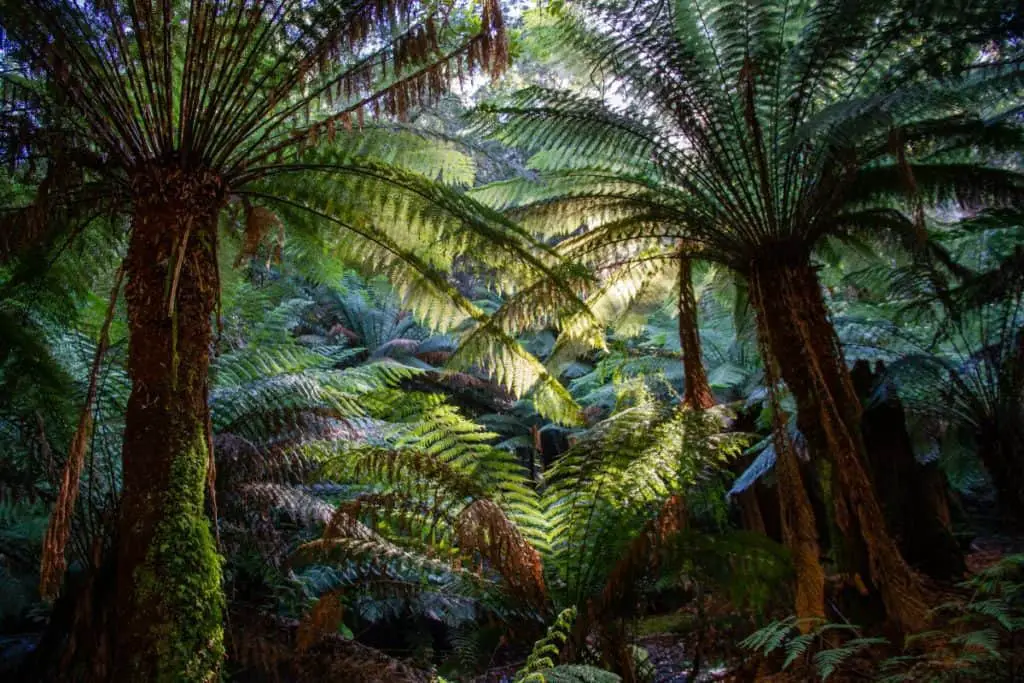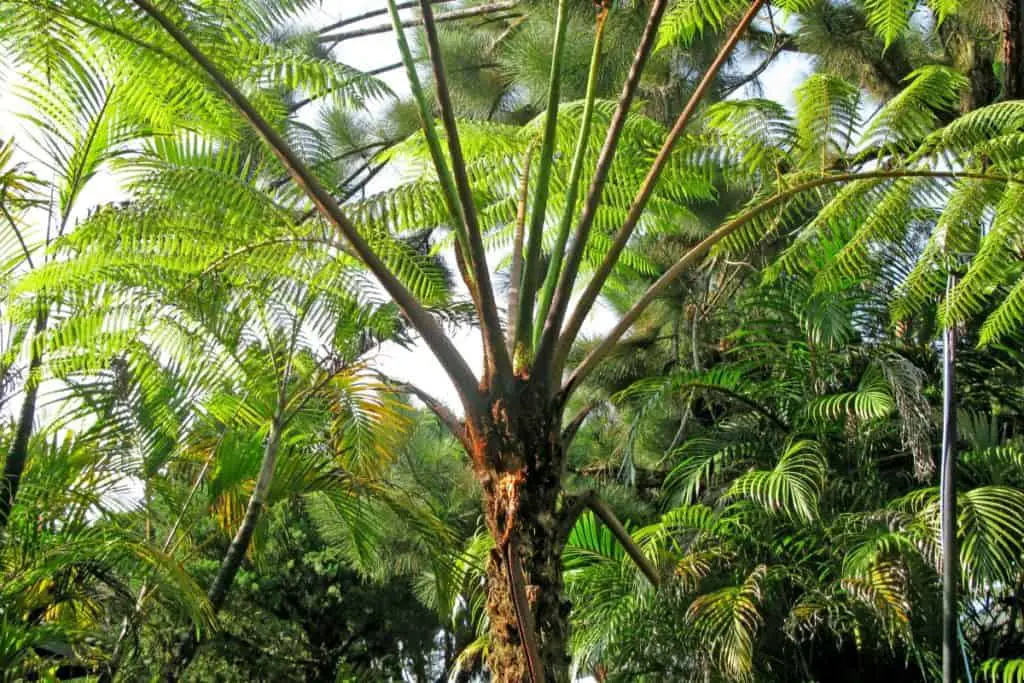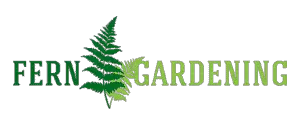Tree ferns are a must-have for the fern lover who wants to make a statement. These fascinating plants are beautiful, eerie, and timeless – conjuring the sense of a prehistoric forest in the present day.

Tree ferns are also a serious investment, being the most expensive varieties of fern, and so it is important to be fully informed before making a buying decision.
Soft tree ferns (Dicksonia antarctica) are the commonest variety and you can expect to pay around $50 per foot of trunk. Specialist nurseries can supply a wider range of varieties and sizes of tree fern that range from around $15 for a plant that has just begun to develop a trunk, up to $1000 for a fully grown fern that tops 10 feet. The cheapest way to buy a tree fern is as spores, but it requires expertise and patience to cultivate a specimen to a satisfying height and spread.
Tree ferns are popular, but can also be difficult to source. There are several reasons why.
First, tree ferns typically grow best in a very particular climate of warm but humid conditions, with good shade, which means the locations where they can be grown on a commercial scale are limited. Second, tree ferns typically grow very slowly, putting on a few centimeters a year at most, meaning growers must invest a lot of time and maintenance effort to supply fully grown specimens. Third, this combination of factors mean that many plant sellers in the US and UK are dependent on importing tree ferns, adding further to costs.
Given all those issues, what options are available to someone who wants to add a tree fern to their garden?
Varieties of tree ferns available
There are two major types of tree ferns that are available commercially – the Dicksonia species ferns and the Cyathea species ferns. There are other upright varieties of fern that are sometimes called tree ferns, such as the Cibotium and Sadleria species (including the Mexican and Hawaiian tree ferns), but these are not so widely available.
Both Dicksonia and Cyathea genera have multiple varieties available, which vary in their growth speed, their cold hardiness, the color and pattern of their fronds, and their tolerance for drought and sun. Some specialist fern nurseries are able to offer a wide range of options. Stock levels fluctuate with season and supply limits, so it’s worth getting in touch to find out the current situation when you are planning to buy.
Larger online retailers like Monrovia, Amazon and Etsy can also be good marketplaces to source stock from local growers, where they sometimes offer bargain prices to clear stock quickly.
Generally speaking, the more exotic the variety of Dicksonia or Cyathea, the higher the price tag. As a yardstick, the two most common varieties are the Tasmanian tree fern (Dicksonia antartica) and the Australian tree fern (Cyathea Cooperi).

Soft tree fern
- Dicksonia antarctica
- Evergreen or semi-evergreen
- Full or partial shade
- Height: up to 4 m
- Soil: acid or neutral. Moist, well-drained.

Australian tree fern
- Cyathea cooperi
- Evergreen
- Partial shade
- Height: up to 5 m
- Soil: acid or neutral. Moist, well-drained.
For a newly established plant in a standard 1 gallon pot, expect to pay around $20-30. In the UK, specimens are more commonly sold based on the height of the trunk, but for a similar plant which has just begun to establish a trunk and is supplied in a 3.5 L pot, the likely price would be £20-30.
How size and age affects price for tree ferns
The main determinant of cost for tree ferns is the age of the plant and the height it has reached. The best illustration of this is for Dicksonia antarctica which can be supplied in a wide variety of sizes.
For the smallest plants, prices start at around $15, but for every additional foot of height, expect to add an additional $40-50 to the cost. This is not always a simple calculation, as very tall specimens can be that bit rarer and so pricier.
For the typical gardener wanting to add a tree fern to their plot, the ambition is usually to make an immediate impact. To achieve this, a 4 to 5 foot plant would be ideal, as it adds immediate height and spread. This is likely to set you back $150-200.
Prices in the UK are in a similar range, with a general rule of £40-50 per foot of height. In the upper range, Paramount plants offer a 3.25 m fern for £852 at the time of writing.
Cheapest tree ferns
For those on a budget, the trade off for reduced cost is time. Newly established tree ferns will take a long time – years or even decades – to reach an impressive height. During this period, careful cultivation is also needed, to protect the plant against cold spells and to ensure that the trunk is regularly watered.
One way to save some money is to buy the tree fern as a “bare trunk”. This is how Tasmanian tree ferns are often supplied from growers in Australia – as trunks that have been pruned of fronds before transport in shipping containers. If you can source this from a wholesaler, it can reduce the price compared to a nursery that has potted and nurtured the fern until new fronds are formed.
Finally, the cheapest possible way of buying a tree fern is also the most risky and labor-intensive. Many suppliers will ship tree fern spores, with prices in the $10 or less range for a dozen or so spores. Be wary, though, as this is not like buying seeds for flowering plants.

Seeds have everything they need to germinate into a new plant, when planted in the right soil and watered well. In contrast, spores cannot spontaneously form new ferns under similar conditions. For flowering plants, fertilization takes place before the seed is formed, with wind or insect pollination leading to the formation of a new fully fertile seed that can germinate into a seedling. Spores are fundamentally different.
When spores are scattered onto moist soil, they can grow into infertile structures known as gametophytes. These tiny structures release sperm cells into the thin layer of water on the surface of the soil, which must make their way to the egg cells elsewhere on the gametophytes to trigger fertilization. In effect, the “pollination” of spores happens on wet surfaces after the spores have been “sown”. Only once the gametophytes have been fertilized will a new fernling (or sporophyte) begin to form.
This process is more fiddly and unreliable than planting seeds, and so should be approached with the right expectations. Buying tree fern spores may prove a false economy if those spores fail to fertilize and germinate.
Even if you do succeed, it is worth bearing in mind that it will be even longer until the fernling you have painstakingly nurtured grows to a four foot trunk to add sculptural beauty to the garden.
Despite the challenges of finding and buying tree ferns it is worth the investment. By following the tips in this article, it should be easier to source a great specimen and add an amazing architectural and horticultural flourish to your garden.
